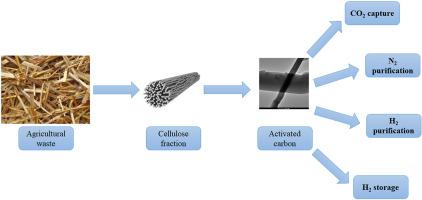Biomass & Bioenergy ( IF 5.8 ) Pub Date : 2021-11-06 , DOI: 10.1016/j.biombioe.2021.106297 N. Chouikhi 1 , J.A. Cecilia 2 , E. Vilarrasa-García 3 , L. Serrano-Cantador 4 , S. Besghaier 1 , M. Chlendi 1 , M. Bagane 1 , E. Rodríguez Castellón 2

|
Several biochars and activated carbons are prepared from cellulose fraction of some agricultural wastes (linen, cotton and wheat). The obtained carbons are characterized by X-ray diffraction (XRD), transmission electronic microscopy (TEM), 13C nuclear magnetic resonance (13C NMR), CO2 adsorption-desorption at 0 °C, Raman spectroscopy and X-ray photoelectron spectroscopy. The biochars are synthesized at different pyrolysis temperatures while activated carbons are obtained from a biochar (pyrolysis at 500 °C) using KOH as activation agent in different amounts. The adsorption values in the biochars increase proportionally to the temperature levels (about 2.5 mmol CO2 g−1 at 25 °C and 760 mm of Hg). The highest the temperature of pyrolytic treatment, the highest the adsorption values. These values remain stable for several cycles in the case of samples synthesized at the highest temperature. The chemical activation of the biochar with KOH improves its microporosity as well as its CO2 adsorption capacity (3.6 mmol CO2 g−1 at 25 °C and 760 mm of Hg). Moreover, these biochars and activated carbons are evaluated for the adsorption of N2 or H2. The N2 and H2 adsorption capacity is much lower than that of CO2. Consequently, these biochars and activated carbons are highly selective for the CO2 capture. They have also shown a high H2 adsorption at −196 °C which makes them having a high potential in H2 storage at low temperature levels.
中文翻译:

农业废弃物作为碳材料的价值化,用于选择性分离和储存 CO2、H2 和 N2
一些生物炭和活性炭是从一些农业废物(亚麻、棉花和小麦)的纤维素部分制备的。获得的碳通过X射线衍射(XRD)、透射电子显微镜(TEM)、13 C核磁共振(13 C NMR)、0°C下CO 2吸附-解吸、拉曼光谱和X射线光电子能谱表征. 生物炭是在不同的热解温度下合成的,而活性炭是从生物炭(在 500°C 下热解)使用不同量的 KOH 作为活化剂获得的。生物炭中的吸附值与温度水平成比例增加(约 2.5 mmol CO 2 g -1在 25 °C 和 760 毫米汞柱下)。热解处理温度最高,吸附值最高。在最高温度下合成的样品的情况下,这些值在几个循环中保持稳定。用 KOH 对生物炭进行化学活化提高了其微孔率和 CO 2吸附能力(3.6 mmol CO 2 g -1在 25 °C 和 760 mm Hg 下)。此外,还评估了这些生物炭和活性炭对 N 2或 H 2的吸附。N 2和H 2 的吸附能力远低于CO 2 的吸附能力。因此,这些生物炭和活性炭对 CO 具有高度选择性2捕获。它们还在-196 °C 下表现出高 H 2吸附,这使得它们在低温水平下具有很高的 H 2储存潜力。











































 京公网安备 11010802027423号
京公网安备 11010802027423号